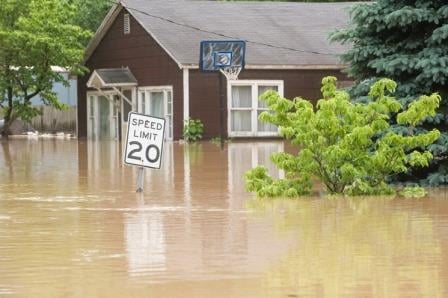“Not your grandparent’s flood” is how Canada’s most quoted climatologist explains the changing nature of flood risk.
It’s not just climate change altering the how the world’s most deadly form of disaster unleashes its wrath, it’s us who’ve changed too.
Learn more about flood insurance here.
“Society’s changed. When you go from a grassland to a cornfield to a parking lot you change the climate of that area,” David Phillips, Environment Canada’s Senior Climatologist said.
Related: Check out Flood Risk 2017 – Florida – a master class
“We’re seeing a transformation of the land use globally and in Canada, 85% of us live in cities…we’re replacing green infrastructure with grey infrastructure and that in fact changes the impact, the fallout of yesterday’s storm.”
Phillips keenly suggests precipitation falling from the sky is only half the equation.
What that precipitation falls on, like a city’s roads and buildings however, completes the whole story of flood risk.
“That so-called typical Canadian flood is different now. Meteorologically, what we’re seeing is weather systems that are slowing down,” Phillips said.
“They used to say the best thing about Canadian weather is that it would hit and run, it wouldn’t stick around and clobber you like in other parts of the world.”
The slower the storm, the greater the damage, according to Phillips.
“What we’re seeing is a slowing down of these weather systems so they have more time to spread their misery,” Phillips said.
Want the latest insurance industry news first? Sign up for our completely free newsletter service now.
“We’re seeing more doses of rain occurring on top of the traditional Canadian flood, we saw it with the Muskoka flood, we saw it with the Calgary flood where it was going to be a typical flood but we got an American flood impinged on a Canadian flood.”
The American style flood Phillips references is related to the lingering weather and could become more common.
“That’s the flood of the future, don’t expect it just to be a snow melt, ice jamming, we could see more heavy doses of rain,” Phillips said.
“We know that the atmosphere holds more moisture when it warms up, so there’s a potential for more days with heavy rain.”
Ultimately, the combination of climate change and changing infrastructure will create the conditions for the floods we will soon experience, Phillips said.
“There’s something else that have made these floods different from our grandparents’ floods,” Phillips said.
“We’ve changed, where we live, what we do with our surfaces, this has exacerbated these floods.”
Related stories:
Could disaster relief in Canada be privatized?
Nearly 550 applications for disaster relief due to Windsor floods


